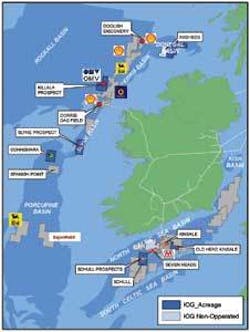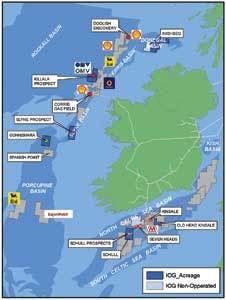OFFSHORE EUROPE
Jeremy Beckman, London,
Oilexco makes bid for Balmoral
Canada’s Oilexco looks set to operate its first major production facility in the UK North Sea. This follows a sale and purchase agreement with CNR International to acquire the latter’s majority interests in theBalmoral floating production platform in UK central North Sea block 16/21 and the associated Balmoral, Glamis, and Stirling fields.
CNR took on these interests as part of a package offloaded by Eni in 2004, but has acted of late in a custodial capacity. Most current production through the Balmoral complex comes from Oilexco’s Brenda and Nicol subsea satellites, which came onstream in June 2007.
Assuming sanction from the UK government and the other field partners, Oilexco will pay $50 million for the Balmoral properties. President and CEO Arthur Mulholland says the company will seek to maximize production efficiency from these fields, adding, “We view theBalmoral PV as being the preferred off-take solution for future satellite developments in the area.”
CNR, meanwhile, will focus its efforts on its remaining UK hubs on the Banff, Murchison, Ninian, and T-block fields.
Earlier, Oilexco had announced plans to drill nine more exploration, development, and appraisal wells on the UK shelf by the end of this year. The exploration prospects are Coronado and Morro on block 22/13b, east of the company’s recent Huntington discovery, and Moth in block 23/21. The appraisal program will focus on Huntington and Kildare, along with the Ptarmigan and Shelley development projects.
The company has engaged two semisubmersibles on long-term contracts for this work. Last month, Diamond Offshore’sOcean Guardian was in block 22/2b delimiting Shelley’s arial extent when fire broke out in the engine room.
This was one of several accidents hampering North Sea operations recently, the most serious being the death of a crew member on the heavy-lift vesselSaipem 7000. The crew member fell overboard during a lifting operation on the Tordis field in the Norwegian sector of the sea. At the time, the vessel was installing a 1,250-metric-ton (1,377 ton) subsea separation module, designed to increase oil recovery. Installation was too far advanced to retrieve the structure to the deck and halt operations.
Earlier, the supply vesselBourbon Surf had collided with Hydro’s Grane platform, and in the UK southern gas basin, a merchant ship also bumped the Viking Echo installation.
Further north, the anchor of another vessel damaged the concrete coating of BP’s Central Area Transmission System (CATS) gas trunkline, causing throughput to be suspended for several weeks until repairs could be effected.
Britain’s Health & Safety Executive reports that incidence of injuries in the UK offshore sector was lower in 2006/07 than it was in the previous year. The number of significant hydrocarbon releases - a prime indicator of hazard management - went up, however, which HSE says is a major concern.
Schull warrants development
Island Oil & Gas is considering a multi-field gas development in the Celtic Sea off southern Ireland, following strong results from a recent well test.
The well, in Exploration License 5/05, tested 21 MMcf/d of dry gas through a restricted choke from the Schull structure, with absolute open flow potential of 40 MMcf/d. Gas flowed from Upper Wealden reservoirs at a measured depth of 2,332-2,559 ft (710-780 m) below the rotary table of the drilling rig,Petrolia.
Island suspended the well as a future producer and has since initiated development studies that would link Schull with its smaller Old Head and West Seven Heads gas discoveries. One of these could be set aside for use as a gas storage facility during periods of peak demand in winter. Another option would be to adapt one field for use as a short-term, national strategic gas reserve.
Schull is southwest of the producing Seven Heads gas field, tied back to Marathon’s Kinsale A platform. Output from any new development would likely also head to the shore via the Kinsale infrastructure. To the north of Seven Heads, Island has a 22% interest in another offshore licensing option where there are plans to drill a Greensand and Upper Wealden gas prospect named Roscarberry. The company has another option, via an agreement with Marathon, to explore oil- and gas-bearing Middle and Lower Wealden sands below Seven Heads and Kinsale Head.
Providence Resources has since taken thePetrolia semi to appraise Hook Head, another old Marathon discovery in the Celtic Sea. One purpose is to test the crest of this accumulation to determine whether the hydrocarbons it contains are oil, gas, or both.
French oil search resumes
Another Canadian independent, Bordeaux Energy, has teamed up with Vermilion Energy Trust and Verenex Energy to drill an exploratory well offshore southwest France. Dolphin Drilling’s semisubmersibleByford Dolphin was due to spud the well in late August on the Orca prospect under contract to Peak Well Management.
Orca-1 will target the largest of six structures identified by on the Aquitaine Maritime permit, 20-80
The offshore area is on the northern edge of the Parentis sub-basin extending onshore, where Vermilion operates 11 fields that have collectively produced 380 MMbbl of oil to date. The company says 12 of the previous wells drilled offshore in this region have encountered oil shows, although none were commercial.

